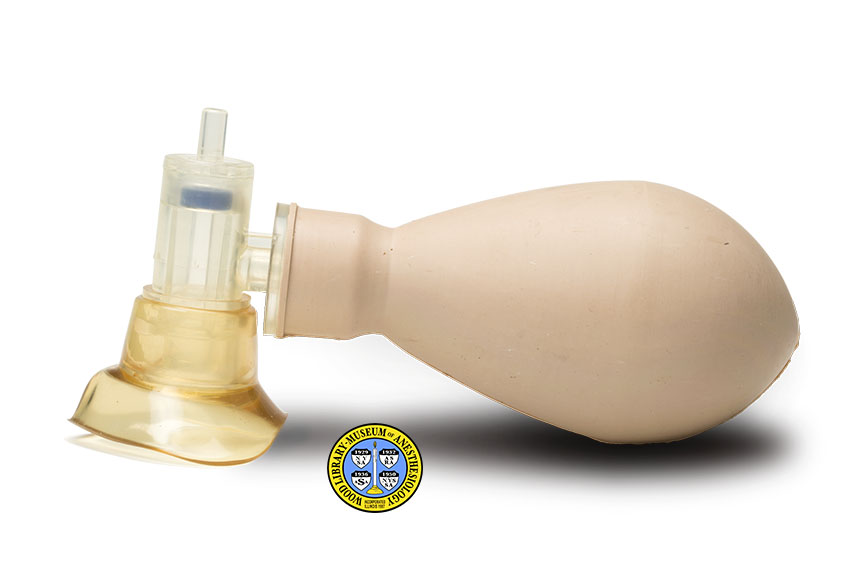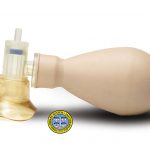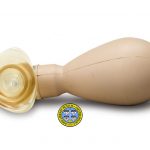Samson Neonatal Resuscitator
South African physician-anaesthetist Heyman H. Samson, M.R.C.S., L.R.C.P. (1911-1990) introduced this manual resuscitator in 1963. He designed it to inflate the small lungs of newborn infants who were not breathing effectively on their own. The example described here was manufactured by Emerson and called the Samson Newborn Lung Inflator. Like other resuscitation bags introduced after the Ambu Bag, this device was also equipped with a self-inflating bag (or bulb).
The valve portion of the resuscitator had a pressure relief function to prevent respirations from being administered at pressures that could damage a newborn's lungs. The bag and valve could be used with the mask (similar to a Rendell-Baker Soucek or RBS mask) that came with the resuscitator, or the mask could be detached so that respirations could be administered through an endotracheal (breathing) tube.
In 1974, Dr. Samson introduced a new version of the resuscitator that had an accordion-like bag and allowed for the administration of higher concentrations of oxygen and very brief moments of higher pressure. A drawback of both styles of Samson resuscitators was that they permitted rebreathing. Use of the Samson resuscitator began to decline in the mid-1980s.
Dr. Samson maintained a home workshop that he used to design a number of other anesthesia devices, including a halothane vaporizer, a low resistance anesthesia circuit and a carbon dioxide absorber. He served as a medical officer during World War II, was a founding member of the South African Society of Anaesthetists and an honorary member of the American Society of Anesthesiologists.
Catalog Record: Samson Neonatal Resuscitator
Access Key: alua
Accession No.: 2000-09-05-1 A
Title: The Samson newborn lung inflator.
Author: Samson, Heyman H. (Harold), 1911-1990.
Corporate Author: J. H. Emerson Co.
Title variation: Alt Title
Title: Resuscitator for the newly born.
Title variation: Alt Title
Title: Samson neonatal resuscitator.
Publisher: Cambridge, MA : Emerson, [between 1984 and 2000?].
Physical Descript: 1 resuscitation apparatus : plastics, silicone ; 7.5 x 15.5 x 8 cm.
Subject: Resuscitation – instrumentation.
Subject: Respiration, Artificial – instrumentation.
Subject: Intensive Care, Neonatal.
Subject: Infant, Newborn.
Subject: Asphyxia Neonatorum.
Note Type: General
Notes: The title was taken from the text on the accompanying packaging.
Note Type: General
Notes: The early year in the date range for the possible year of manufacture of this
example is based on the year that J. H. Emerson Co. applied for their 510(k)
premarket notification with the FDA (1984). The end date in the date range
for the possible year of manufacture is based on the year that this device
was donated to the WLM (2000). The date range could change if documentation
that indicates the dates should be corrected is discovered.
Note Type: Citation
Notes: 510(k) Premarket Notification: Samson’s Newborn Lung Inflator. FDA: U.S. Food
and Drug Administration website. July 6, 1984. https://www.accessdata.fda.
gov/SCRIPTS/cdrh/cfdocs/cfPMN/pmn.cfm?ID=K842487. Accessed May 2, 2015.
Note Type: Citation
Notes: Barnes TA. Emergency ventilation techniques and related equipment. Respir
Care. 1992;37(7):682. https://archive.org/details/respiratorycareo377amerrich
Accessed Mary 3, 2015.
Note Type: Citation
Notes: Gordon PC. Pioneers in South African Anaesthesia: Dr Heyman Harold (Heymie)
Samson, anaesthetic innovator. South Afr J Anaesth Analg. 2014;20(1):10-12.
https://www.tandfonline.com/doi/pdf/10.1080/22201173.2014.10844557. Accessed
May 2, 2015.
Note Type: Citation
Notes: Heyman Harold Samson. S Afr Med J. July 21, 1990;78:117. https://archive.samj.
org.za/1990%20VOL%20LXXVIII%20Jul-Dec/Articles/01%20July/2.17%20IN%20MEMORIAM
pdf. Accessed May 2, 2015.
Note Type: Citation
Notes: Samson HH. An improved carbon dioxide absorber. Anesthesiology.
1957;18(2):339-341. https://anesthesiology.pubs.asahq.org/Article.
aspx?articleid=1970439. Accessed May 2, 2015. https://archive.samj.org.
za/1974%20VOL%20XLVIII%20Jan%20-Jun/Articles/03%20March/6.
5%20RESUSCITATION%20OF%20THE%20NEWBORN.
AN%20IMPROVED%20NEONATAL%20RESUSCITATOR.pdf. Accessed May 2, 2015.
Note Type: Citation
Notes: Samson HH, inventor. Resuscitator for the newly born. US patent 3,330,272.
July 11, 1967. www.google.com/patents/US3330272. Accessed May 2, 2015.
[Application filed October 28, 1963.]
Note Type: Citation
Notes: Samson HH, Moyes DG. Valveless anaesthetic circuits incorporating scavenging.
S Afr Med J. 1980;57(23):955-958. https://archive.samj.org.
za/1980%20VOL%20LVII%20%20Jan-Jun/Articles/06%20June/1.
10%20VALVELESS%20ANAESTHETIC%20CIRCUITS%20INCORPORATING%20SCAVENGING.%20H.H.
%20Samson%20and%20D.G.%20Moyes.pdf. Accessed May 2, 2015.
Note Type: Citation
Notes: Samson HH. A new anaesthetic vaporizer. S Afr Med J. 1966;40(12):264-265.
https://archive.samj.org.za/1966%20VOL%20XL%20Jan-Jun/Articles/03%20March/4.
5%20A%20NEW%20ANAESTHETIC%20VAPORIZER,%20H.H.Samson,%20M.B.E,%20M.R.C%20.S,
%20L.R.C.P.pdf. Accessed May 2, 2015.
Note Type: Citation
Notes: Samson HH. Resuscitation of the newborn: an improved neonatal resuscitator. S
Afr Med J. 1974;48(15):628-630. https://archive.samj.org.
za/1974%20VOL%20XLVIII%20Jan%20-Jun/Articles/03%20March/6.
5%20RESUSCITATION%20OF%20THE%20NEWBORN.
AN%20IMPROVED%20NEONATAL%20RESUSCITATOR.pdf. Accessed May 2, 2015.
Note Type: Not Applicable
Notes: Samson HH. A resuscitator for neonates. Med Proc (Johannesb). 1963;9:158-160.
Note Type: Physical Description
Notes: One very small oronasal mask, valve and resuscitation bag (referred to as
‘resuscitator’ in the remainder of the physical description note); The
measurements, and this description, are based on a patient’s perspective; The
measurements in the physical description field are of the packaging that
accompanies the resuscitator; The resuscitator itself measures approximately
15.3 cm x 5.6 x 7.6 cm (height x width x depth, patient perspective); The
mask is made of a flexible, clear plastic or silicone material, and has a
low profile and triangular shape (Rendell-Baker-like shape); The material of
the mask has yellowed with age; The mask measures approximately 4.2 cm in
height and 5.2 cm in width; The bag is bulb shaped and measures approximately
11.1 cm in height and 6 cm in diameter at its widest point; The bag is a
light tan colored silicone material; The non-rebreathing/pressure relief
valve is clear plastic and has a port for attaching oxygen tubing; There are
no manufacturer markings on the resuscitator, but there are on the
accompanying packaging; The packaging (box) is made of a thin, transparent,
light amber colored plastic; A piece of paper, folded into the box, bears
printing on both sides; The print and images are all in shades of black and
grey; Printed on the top is, “the SAMSON newborn lung inflator”, the Emerson
name and logo, and “The SAMSON NEWBORN LUNG INFLATOR is designed to
facilitate the establishment of the functional residual capacity in the
newborn.”; Also printed on the front of the box is “the SAMSON newborn lung
inflator”, the Emerson name and logo, as well as a photograph of an infant
and squeezing the index finger of an adult hand; On the back is printed, “For
further information, refer to the descriptive literature, or contact: EMERSON
[new line] J.H. EMERSON CO. [new line] 22 Cottage Park Avenue [new line]
Cambridge, MA 02140 [new line] Phone (617) 864-1414”; The following is
printed to the right of the address, “SAMSON NEWBORN LUNG INFLATOR [new line]
Reorder: Part No. 340-1000”; On the inside of the box, printed on the back is
“method of operation:” [new line] It is recommended that the bulb of the
SAMSON NEWBORN LUNG INFLATOR be compressed as completely and rapidly as
possible. Excess gas will be vented through the pressure escape vent hole.”;
On the inside of the box, printed on the front is, “technical information:
Dimensions: 15 cm L x 5 CM W x 7.5 cm H ….. FEDERAL LAW (USA) RESTRICTS THIS
DEVICE TO USE BY OR AT THE DIRECTION OF A PHYSICIAN”; The following is
printed on the inside bottom, “precautions: This device comes pre-assembled.
Should it become necessary to detach and then re-attach the bulb, a firm
twisting action should be employed to assure a tight fit. [new line] DO NOT
ATTEMPT TO RESTERILIZE THIS DEVICE BY METHODS EMPLOYING TEMPERATURES
EXCEEDING 80° C. [new line] FOR MAXIMUM EFFICIENCY, THE SAMSON NEWBORN LUNG
INFLATOR SHOULD BE USED, WHEN POSSIBLE, WITH A NEONATAL ENDOTRACHEAL TUBE.”;
A label that seems to have come loose from the box is printed with the
following, “EMERSON [new line] Part # 340-1000 [new line] Lot# 86-154 [new
line] disposable [new line] discard after single use [new line] sterile [new
line] unless package has been opened or damaged [new line] ethylene oxide
sterilized …”
Note Type: Reproduction
Notes: Photographed for the WLM by Mr. Steve Donisch, January 12, 2015.
Note Type: Acquisition
Notes: Donated to the WLM by George S. Bause, MD, the Wood Library-Museum of
Anesthesiology Honorary Curator.
Note Type: Historical
Notes: South African physician-anaesthetist Heyman H. Samson, M.R.C.S., L.R.C.P. (1911-1990) introduced this manual resuscitator in 1963. He designed it to inflate the small lungs of newborn infants who were not breathing effectively on their own. The example described here was manufactured by Emerson and called the Samson Newborn Lung Inflator. Like other resuscitation bags introduced after the Ambu Bag, this device was also equipped with a self-inflating bag (or bulb).
The valve portion of the resuscitator had a pressure relief function to prevent respirations from being administered at pressures that could damage a newborn’s lungs. The bag and valve could be used with the mask (similar to a Rendell-Baker Soucek or RBS mask) that came with the resuscitator, or the mask could be detached so that respirations could be administered through an endotracheal (breathing) tube.
In 1974, Dr. Samson introduced a new version of the resuscitator that had an accordion-like bag and allowed for the administration of higher concentrations of oxygen and very brief moments of higher pressure. A drawback of both styles of Samson resuscitators was that they permitted rebreathing. Use of the Samson resuscitator began to decline in the mid-1980s.
Dr. Samson maintained a home workshop that he used to design a number of other anesthesia devices, including a halothane vaporizer, a low resistance anesthesia circuit and a carbon dioxide absorber. He served as a medical officer during World War II, was a founding member of the South African Society of Anaesthetists and an honorary member of the American Society of Anesthesiologists.
Note Type: Publication
Notes: Davies VA, Rothberg AD, Argent AC, Cooper PA. A comparison of two
resuscitators in the management of birth asphyxia. S Afr Med J.
1985;68(1):19-22.
Note Type: Exhibition
Notes: Selected for the WLM website (noted March 26, 2015).



